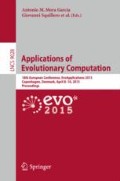Abstract
Most frequent surface shapes of man-made constructions are planar surfaces. Discovering those surfaces is a big step toward extracting as-built/-is construction information from 3D point cloud. In this paper, a real-coded genetic algorithm (GA) formulation for planar surfaces recognition in 3D point clouds is presented. The algorithm developed based on a multistage approach; thereby, it finds one planar surface (part of solution) at each stage. In addition, the logarithmically proportional objective function that is used in this approach can adapt itself to scale and spatial density of the point cloud. We tested the proposed application on a synthetic point cloud containing several planar surfaces with different shapes, positions, and with a wide variety of sizes. The results obtained showed that the proposed method is capable to find all plane’s configurations of flat surfaces with a minor distance to the actual configurations.
Access this chapter
Tax calculation will be finalised at checkout
Purchases are for personal use only
References
Tang, P., Anil, E., Akinci, B., Huber, D.: Efficient and effective quality assessment of as-is building information models and 3D laser-scanned data. In: Proceedings of ASCE International Workshop on Computing in Civil Engineering, pp. 486–493. McGraw-Hill (2011)
Tang, P., Huber, D., Akinci, B., Lipman, R., Lytle, A.: Automatic reconstruction of as-built building information models from laser-scanned point clouds: A review of related techniques. Autom. Constr. 19, 829–843 (2010)
Jiang, X., Bunke, H.: Robust and fast edge detection and description in range images. In: Proceedings of IAPR Workshop on Machine Vision Applications, pp. 538–541 (1996)
Vosselman, G., Gorte, B., Sithole, G., Rabbani, T.: Recognising structure in laser-scanner point clouds. In: International Archives of the Photogrammetry, Remote Sensing and Spatial Information Sciences, vol. XXXVI-8/W2, pp. 33–38 (2004)
Gorte, B.: Segmentation of TIN-structured surface models. In: Proceedings Joint International Symposium on Geospatial Theory, Processing and Applications (2002)
He, Y., Zhang, C., Awrangjeb, M., Fraser, C.: Automated reconstruction of walls from airborne lidar data for complete 3D building modelling. In: International Archives of the Photogrammetry, Remote Sensing and Spatial Information Sciences, vol. XXXIX-B3, pp. 115–120 (2012)
Tarsha-Kurdi, F., Landes, T., Grussenmeyer, P.: Hough-transform and extended RANSAC algorithms for automatic detection of 3D building roof planes from lidar data. In: ISPRS Workshop on Laser Scanning, vol. XXXVI (2007)
Peternell, M., Steiner, T.: Reconstruction of piecewise planar objects from point clouds. Comput. Aided Des. 36, 333–342 (2004)
Sanchez, V., Zakhor, A.: Planar 3D modeling of building interiors from point cloud data. In: 19th IEEE International Conference on Image Processing (ICIP), pp. 1777–1780 (2012)
Ozog, P., Eustice, R.M.: Real-time SLAM with piecewise-planar surface models and sparse 3D point clouds. In: Proceedings of the IEEE/RSJ International Conference on Intelligent RObots and Systems (IROS), pp. 1042–1049 (2013)
Jenke, P., Huhle, B., Straßer, W.: Statistical reconstruction of indoor scenes. In: International Conference in Central Europe on Computer Graphics, Visualization and Computer Vision (WSCG 2009), pp. 17–24 (2009)
Chen, J., Chen, B.: Architectural modeling from sparsely scanned range data. Int. J. Comput. Vis. 78, 223–236 (2008)
Vosselman, G., Dijkman, S.: 3D building model reconstruction from point clouds and ground plans. In: International Archives of the Photogrammetry, Remote Sensing and Spatial Information Sciences, vol. XXXIV-3/W4, pp. 37–43 (2001)
Yousefzadeh, M., Leurink, F.H.M., Beheshti Jou, M.: A general data-driven algorithm for façade structure modeling using ground based laser data. In: International Archives of the Photogrammetry, Remote Sensing and Spatial Information Sciences, vol. XL-3, pp. 381–386 (2014)
Mahfoud, S.W.: A comparison of parallel and sequential niching methods. In: Eshelman, L.J. (ed.) Proceedings of the 6th International Conference on Genetic Algorithms, pp. 136–143. Morgan Kaufmann, Pittsburgh (1995)
Horn, J.: The nature of niching: Genetic algorithms and the evolution of optimal, cooperative populations. Technical report IlliGAL No. 97008, University of Illinois at Urbana-Champaign (1997)
Bazargani, M., Mateus, L., Loja, M.A.R.: Logarithmically proportional objective function for planar surfaces recognition in 3D point cloud. In: Sixth World Congress on Nature and Biologically Inspired Computing (NaBIC 2014). IEEE (2014)
Deb, K., Agrawal, R.B.: Simulated binary crossover for continuous search space. Complex Syst. 9, 115–148 (1995)
Deb, K., Anand, A., Joshi, D.: A computationally efficient evolutionary algorithm for real-parameter optimization. Evol. Comput. 10, 371–395 (2002)
Deb, K., Agrawal, S.: A niched-penalty approach for constraint handling in genetic algorithms. In: Artificial Neural Nets and Genetic Algorithms: Proceedings of the International Conference, pp. 235–243. Springer (1999)
Deb, K., Deb, D.: Analysing mutation schemes for real-parameter genetic algorithms. Int. J. Artif. Intell. Soft Comput. (IJAISC) 4, 1–28 (2014)
Harik, G.R., Cantú-Paz, E., Goldberg, D.E., Miller, B.L.: The gambler’s ruin problem, genetic algorithms, and the sizing of populations. Evol. Comput. 7, 231–253 (1999)
Acknowledgments
The authors would like to thank Fernando Lobo for his valuable comments and suggestions. This work was sponsored by the Portuguese Foundation for Science and Technology under grant PTDC/ATP-AQI/5355/2012.
Author information
Authors and Affiliations
Corresponding author
Editor information
Editors and Affiliations
Rights and permissions
Copyright information
© 2015 Springer International Publishing Switzerland
About this paper
Cite this paper
Bazargani, M., Mateus, L., Loja, M.A.R. (2015). Planar Surfaces Recognition in 3D Point Cloud Using a Real-Coded Multistage Genetic Algorithm. In: Mora, A., Squillero, G. (eds) Applications of Evolutionary Computation. EvoApplications 2015. Lecture Notes in Computer Science(), vol 9028. Springer, Cham. https://doi.org/10.1007/978-3-319-16549-3_43
Download citation
DOI: https://doi.org/10.1007/978-3-319-16549-3_43
Published:
Publisher Name: Springer, Cham
Print ISBN: 978-3-319-16548-6
Online ISBN: 978-3-319-16549-3
eBook Packages: Computer ScienceComputer Science (R0)

